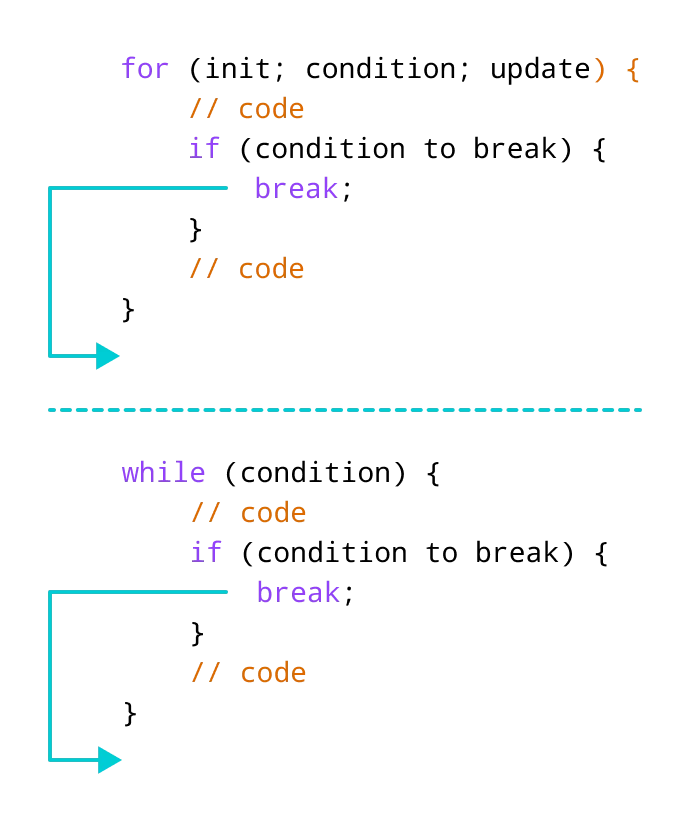In C#, we use the break statement to terminate the loop.
As we know, loops iterate over a block of code until the test expression is false. However, sometimes we may need to terminate the loop immediately without checking the test expression.
In such cases, the break statement is used. The syntax of break statement is,
break;
Before we learn about break, make sure to learn about
Example: C# break statement with for loop
using System;
namespace CSharpBreak {
class Program {
static void Main(string[] args) {
for (int i = 1; i <= 4; ++i) {
// terminates the loop
if (i == 3) {
break;
}
Console.WriteLine(i);
}
Console.ReadLine();
}
}
}
Output
1 2
In the above program, our for loop runs 4 times from i = 1 to 4. However, when i is equal to 3, the break statement is encountered.
if (i == 3) {
break;
}
Now, the loop is terminated suddenly. So, we only get 1 and 2 as output.
Note: The break statement is used with decision-making statements like if..else.
Example: C# break statement with while loop
using System;
namespace WhileBreak {
class Program {
static void Main(string[] args) {
int i = 1;
while (i <= 5) {
Console.WriteLine(i);
i++;
if (i == 4) {
// terminates the loop
break;
}
}
Console.ReadLine();
}
}
}
Output
1 2 3
In the above example, we have created a while loop that is supposed to run from i = 1 to 5.
However, when i is equal to 4, the break statement is encountered.
if (i == 4) {
break;
}
Now, the while loop is terminated.
Working of break statement in C#

break Statement with Nested Loop
We can also use the break statement with nested loops. For example,
using System;
namespace NestedBreak {
class Program {
static void Main(string[] args) {
int sum = 0;
for(int i = 1; i <= 3; i++) { //outer loop
// inner loop
for(int j = 1; j <= 3; j++) {
if (i == 2) {
break;
}
Console.WriteLine("i = " + i + " j = " +j);
}
}
Console.ReadLine();
}
}
}
Output
i = 1 j = 1 i = 1 j = 2 i = 1 j = 3 i = 3 j = 1 i = 3 j = 2 i = 3 j = 3
In the above example, we have used the break statement inside the inner for loop. Here, the break statement is executed when i == 2.
Hence, the value of i = 2 is never printed.
Note: The break statement only terminates the inner for loop. This is because we have used the break statement inside the inner loop.
If you want to learn the working of nested loops, visit C# Nested Loops.
break with foreach Loop
We can also use the break statement with foreach loops. For example,
using System;
namespace ForEachBreak {
class Program {
static void Main(string[] args) {
int[] num = { 1, 2, 3, 4, 5 };
// use of for each loop
foreach(int number in num) {
// terminates the loop
if(number==3) {
break;
}
Console.WriteLine(number);
}
}
}
}
Output
1 2
In the above example, we have created an array with values: 1, 2, 3, 4, 5. Here, we have used the foreach loop to print each element of the array.
However, the loop only prints 1 and 2. This is because when the number is equal to 3, the break statement is executed.
if (number == 3) {
break;
}
This immediately terminates the foreach loop.
break with Switch Statement
We can also use the break statement inside a switch case statement. For example,
using System;
namespace ConsoleApp1 {
class Program {
static void Main(string[] args) {
char ch='e';
switch (ch) {
case 'a':
Console.WriteLine("Vowel");
break;
case 'e':
Console.WriteLine("Vowel");
break;
case 'i':
Console.WriteLine("Vowel");
break;
case 'o':
Console.WriteLine("Vowel");
break;
case 'u':
Console.WriteLine("Vowel");
break;
default:
Console.WriteLine("Not a vowel");
}
}
}
}
Output
Vowel
Here, we have used the break statement inside each case. It helps us to terminate the switch statement when a matching case is found.
To learn more, visit C# switch statement.